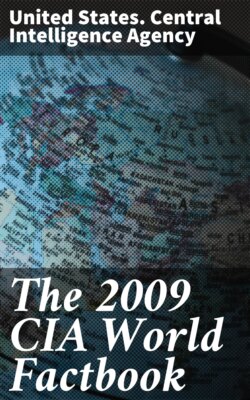Читать книгу The 2009 CIA World Factbook - United States. Central Intelligence Agency - Страница 133
На сайте Литреса книга снята с продажи.
FAX: [54] (11) 5777–4240
ОглавлениеFlag description:
three equal horizontal bands of light blue (top), white, and light blue; centered in the white band is a radiant yellow sun with a human face known as the Sun of May; the colors represent the clear skies and snow of the Andes; the sun symbol commemorates the appearance of the sun through cloudy skies on 25 May 1810 during the first mass demonstration in favor of independence; the sun features are those of Inti, the Inca god of the sun
Economy ::Argentina
Economy - overview:
Argentina benefits from rich natural resources, a highly literate population, an export-oriented agricultural sector, and a diversified industrial base. Although one of the world's wealthiest countries 100 years ago, Argentina suffered during most of the 20th century from recurring economic crises, persistent fiscal and current account deficits, high inflation, mounting external debt, and capital flight. A severe depression, growing public and external indebtedness, and a bank run culminated in 2001 in the most serious economic, social, and political crisis in the country's turbulent history. Interim President Adolfo RODRIGUEZ SAA declared a default - the largest in history - on the government's foreign debt in December of that year, and abruptly resigned only a few days after taking office. His successor, Eduardo DUHALDE, announced an end to the peso's decade-long 1-to-1 peg to the US dollar in early 2002. The economy bottomed out that year, with real GDP 18% smaller than in 1998 and almost 60% of Argentines under the poverty line. Real GDP rebounded to grow by an average 9% annually over the subsequent five years, taking advantage of previously idled industrial capacity and labor, an audacious debt restructuring and reduced debt burden, excellent international financial conditions, and expansionary monetary and fiscal policies. Inflation also increased, however, during the administration of President Nestor KIRCHNER, which responded with price restraints on businesses, as well as export taxes and restraints, and beginning in early 2007, with understating inflation data. Cristina FERNANDEZ DE KIRCHNER succeeded her husband as President in late 2007, but was stymied in her efforts to hike export taxes still further by protesting farmers. Her government nationalized private pension funds in late 2008, which bolstered government coffers, but failed to assuage investors' concerns about the direction of economic policy.
GDP (purchasing power parity):
$575.2 billion (2008 est.) country comparison to the world: 24 $538.6 billion (2007 est.)
$495.5 billion (2006 est.)
note: data are in 2008 US dollars
GDP (official exchange rate):
$324.8 billion (2008 est.)
GDP - real growth rate:
6.8% (2008 est.) country comparison to the world: 41 8.7% (2007 est.)
8.5% (2006 est.)
GDP - per capita (PPP):
$14,200 (2008 est.) country comparison to the world: 80 $13,400 (2007 est.)
$12,500 (2006 est.)
note: data are in 2008 US dollars
GDP - composition by sector:
agriculture: 9.9%
industry: 32.7%
services: 57.4% (2008 est.)
Labor force:
16.27 million country comparison to the world: 36 note: urban areas only (2008 est.)
Labor force - by occupation:
agriculture: 1%
industry: 23%
services: 76% (2008 est.)
Unemployment rate:
7.9% (2008 est.) country comparison to the world: 108 8.5% (2007 est.)
Population below poverty line:
23.4% (January-June 2007)
Household income or consumption by percentage share:
lowest 10%: 1%
highest 10%: 35% (January-March 2007)
Distribution of family income - Gini index:
49 (January-March 2007) country comparison to the world: 27
Investment (gross fixed):
23.2% of GDP (2008 est.) country comparison to the world: 65
Budget:
revenues: $86.65 billion
expenditures: $82.85 billion (2008 est.)
Public debt:
48.6% of GDP (2008 est.) country comparison to the world: 40 118% of GDP (June 2004 est.)
Inflation rate (consumer prices):
8.6% (2008 est.) country comparison to the world: 132 8.8% (2007 est.)
note: based on official estimates, which lack credibility; non-official estimates put inflation at 22% in 2008
Central bank discount rate:
